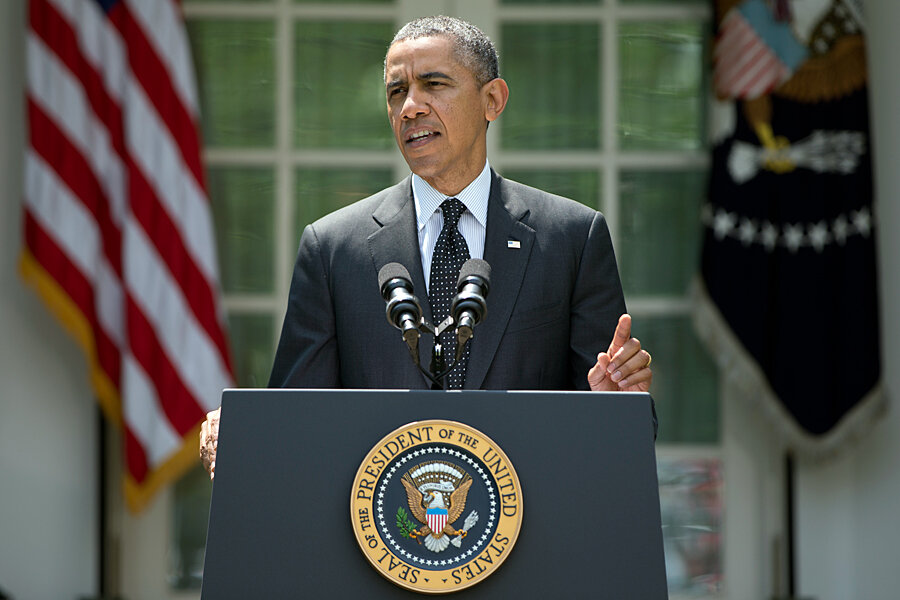Obama's half-full, half-empty Afghanistan plan
Loading...
| Washington
President Obama began to write the final chapter of the war in Afghanistan Tuesday, with his highly anticipated announcement that 9,800 US troops will remain in the country after 2014 – and, equally important, that by the end of 2015 that number is set to be reduced by half, to 5,000.
These figures came as little surprise to US military officials – it’s the number that had been widely predicted within the halls of the Pentagon. Still, it came as a relief for commanders who argued against pulling out all US troops by year’s end – known the “zero option” – which, even when accused of bluffing, the White House had insisted was a real possibility earlier this year
Still, the news set off a flurry of rebuke among Republican lawmakers who want the war to continue apace. “President Obama is not ending wars, he’s losing them,” Sen. Lindsey Graham (R) of South Carolina tweeted.
He teamed up with fellow Republican Sens. John McCain of Arizona and Kelly Ayotte of New Hampshire in condemning the move, which they charged in a joint statement was a “disastrous decision” that would “embolden our enemies and discourage our partners in Afghanistan.” They added: “Wars do not end just because politicians say so.”
Yet as commander in chief, Mr. Obama does have precisely that say-so in the form of the power to determine the ongoing commitment of US troops to America’s longest war.
The White House is well aware, too, that half of all Americans in a Gallup poll last February said that the war in Afghanistan was a mistake – and that those figures have been steadily rising from 25 percent in 2004 to 30 percent in 2008 and 40 percent in 2010.
Obama has never held the lofty goals of democratization professed by his predecessor, President George W. Bush, and in his announcement Tuesday he sought to keep expectations low.
“We have to recognize that Afghanistan will not be a perfect place,” he said. “And it is not America’s responsibility to make it one.”
What the US can do, he said, is to give Afghans a chance to seek a long overdue peace. The question, analysts say, is whether this latest strategic move will work toward that end.
The decision to keep 10,000 troops in the country – almost as many troops as the commander of US forces in Afghanistan, Gen. Joseph Dunford, requested – signals commitment to that end, says Stephen Biddle, an adjunct senior fellow for defense policy at the Council on Foreign Relations and a professor of international affairs at George Washington University in Washington.
Roughly 10,000 troops will be enough to cover the narrow mission given to the US military in 2014, which will be to train Afghan forces, and will also be enough to provide force security, adds retired Gen. David Barno, co-director of the Responsible Defense Program at the Center for a New American Security and the commander of US troops in Afghanistan from 2003 to 2005.
The potentially problematic part, many analysts say, is the announcement that these troop levels will be cut in half by the end of 2015.
“You have an adequate force coming in, but then you’ve announced a timeline and a rapid drawdown,” Mr. Barno says. “I kind of question how this is going to work out.”
The fact that the troop count falls rapidly after 2015 – and that the president announced it will be happening – sends an ambiguous message, Dr. Biddle adds.
The administration believes the US has limited strategic interests in Afghanistan, but the new course of action “takes the middle route where you lose expensively instead of losing cheaply,” he says.
Currently, Afghanistan is militarily stalemated, Biddle says, and it can stay that way “indefinitely” as long as the Afghan military is well funded. That’s going to take some doing, since the operating budget for the Afghan National Security Forces (ANSF) is currently twice the revenue of the entire Afghan government.
Whether the government of Afghanistan ultimately collapses or not depends on whether Congress keeps writing checks to give the Afghan government time to engage in peace talks with the Taliban – which could take years, Biddle adds.
“Among the problems with that, though, is that the Taliban are not going to make any compromises at all in any kind of settlement if they think ANSF funding is going to be cut and they will get all they want without having to make concessions,” he says. “If you want a settlement, then you have to find some way to keep funding multiyear negotiations.”
The congressional willingness to keep the money coming correlates closely, however, with whether or not there are any Americans in the country. If Obama had chosen the zero option, for example, there’s a good chance that Congress would have pulled the plug on Afghan funding at the end of 2014, too, Biddle notes.
As a result, the war could come down to a “contest in stamina between the Congress and the Taliban,” he adds. “That’s what the basic strategic calculus is right now.”







